Table of Contents Hide

What Is Outdoor Area Lighting
Outdoor lighting extends the usability of exterior spaces, outdoor facilities and road infrastructure into the evening. Area luminaires are outdoor lighting systems designed to illuminate specific geometric areas. The principal purpose of area lighting is to produce accurate and comfortable visibility, thereby facilitating the proper use of outdoor facilities and spaces for nighttime social, recreational, sports and business activities. This quality of visibility contributes to safe, secure and efficient traffic movements within residential, commercial and industrial areas. The role of area lighting has also evolved to transforming the look of an outdoor space by creating aesthetic enhancement of decorative lighting.Area Lighting Applications
The main starting point when considering outdoor lighting is to establish the primary design goal. Traditionally, street lighting has been the basic component of outdoor lighting. In modern urban settings, however, it is mostly area lighting that defines visual environment, provides human-scale illumination, creates the desired ambience, offers a sense of safety and security, and enables execution of a variety of outdoor tasks at night. While street lighting is designed to provide an enhanced visual environment for people to safely use the road system, area lighting lays an emphasis on creating visibility for areas within specified boundaries such as parking lots, pedestrian malls, downtown squares, office complexes, exhibition areas, residential areas, sports grounds, company grounds, campuses, parks, airports, toll plazas, rail yards, loading docks, and building perimeters.Street lights in many cases can serve as area lights as long as their light distribution patterns meet the requirement of area lighting. Area lights are more versatile in terms of light output, optical pattern, mounting height, fixture style, aesthetic characteristics, quantity and quality of illumination. Area lighting systems designed with a utilitarian focus are found in outdoor facilities for industrial, transport, sports, parking, and large open-area lighting applications. These lighting systems must accommodate both vehicular and pedestrian traffic, produce adequate light output, and endure harsh operating environments, all in the most economical way possible. Area lights for pedestrian-scale applications are usually designed to aesthetically match the architectural theme of a space while providing functionality. Their daytime appearance infuses an organic look into the urban environment. The pole height and luminaire size must be scaled to perfection for both effective pedestrian lighting and aesthetic effects. In addition to delivering functional lighting and enhancing the architectural setting in parks, squares, and other open-area pedestrian zones, this type of fixtures also takes the role of street lighting for pedestrian paths, bikeways, and narrow roads within private premises.
Types of Area Lights
As mentioned previously, area lighting has a wide array of applications that range from industrial, commercial, and residential to municipal and institutional lighting. Where there're frequent human activities in the open air during hours of darkness, there are fixed-mount area light fixtures. The versatility of application leads to the proliferation of styles, designs, scales and functionalities of area lighting systems. Area light fixtures can be divided into these categories:High mast lights
High mast lights are designed to illuminate large areas such as highway interchanges, parking lots, airports and the like. The far-field lighting system is mounted at a height of 20 meters (65 ft.) and up. The high mounting height and incorporation of multiple luminaires on a single pole result in an extensive illumination coverage and minimum number of obstructions. In airports, container yards, sports fields and other high activity spaces with limited land for trenching and installing the foundations, high mast lighting provides greater field visibility, deployment flexibility and infrastructure savings compared with any other outdoor lighting solutions. In a high mast system, a cluster of luminaires are mounted to a support ring which can be raised and lowered by a drive mechanism. The mast structure has been subjected to full-scale wind tunnel testing to ensure that the high mast system can sustain an assumed maximum reaction arising from a wind speed. High mast systems typically use high wattage luminaires available in both symmetrical and asymmetrical distributions.Post top lights
Post top lights are pedestrian-scale light fixtures with luminaire mounting heights ranging from 3 to 9 meters. In addition to the lighting performance and optical control, aesthetics, scaling and styling are other top priorities in every post top fixture design. Available in a multitude of both traditional and contemporary forms, post top lights blend well in many settings which include downtown streetscapes, city parks, residential neighborhoods, walkways and bikeways. The traditional aesthetics are delivered typically by acorn and lantern styles luminaires which are mounted atop fluted and/or tapered poles with decorative bases. Contemporary designs utilize sleek lines and clean geometries to ensure a consistent look that is in harmony with the architecture of surrounding structures. An appropriate balance should be placed between the pole and luminaire to ensure the entire fixture will not look out of scale and miss-matched.Architectural area lights
Architectural area lights embrace a design philosophy of creating the perfect coupling of form and function to round out an engaging blend of art, sculpture and light. With signature clean lines and attractive geometric forms, this types of fixture can create aesthetic harmony with the surrounding architecture. Architectural area lights are a cousin of post top lights, serving a similar purpose but carrying more freedom of design expression. They both help define space, give scale and reveal the distinctive design sensibility. Today's architectural area lights typically come with an organic integration of the fixture, light engine and optical system to deliver visually comfortable illumination in a visually intriguing form.Roadway luminaires
Roadway luminaires or street lights exhibit a range of symmetrical and asymmetrical distributions that make them one of the primary solutions for area lighting applications requiring mounting heights of 8 to 15 meters (26 to 50 ft). Roadway luminaires for area lighting applications are typically mounted on straight poles using slipfitters, spigots, brackets or yoke mounts, rather than on davit-style, truss-style, or mast-arm poles which are usually found in roadway and street lighting applications. As with architectural area lights, this type of area luminaires increasingly follow the trend towards the fusion of form and function in order to create a sleek aesthetic and blend nicely in a contemporary setting.Wall mounted floodlights
Wall mounted area lights are asymmetrical light fixtures providing illumination up to 6 - 8 times the mounting height (8 meters or less) in front of the luminaires. The lateral spacing is typically limited to 2 times the mounting height. This type of area lights are available in many styles for integration with various architectural composition. Wall mounted area lights find their applications in residential and commercial areas such as parking lots, outlet exteriors, loading docks, entrances, patios, swimming pools, or whatever exterior area that requires illumination for nighttime visibility, safety or security.Lighting Technology
Reducing the energy expense in outdoor lighting has been driven the never-ending quest for new technologies. In the past, one of the main justifications for using high-intensity discharge (HID) lamps such as high pressure sodium (HPS) and metal halide (MH) lamps was energy efficiency. However, the ongoing maintenance cost, optical control, and light quality of HID systems presented a great challenge that remains to be addressed. As such, the outdoor lighting market has been rapidly switching to LED lighting, which offers a solution that makes up for the limitations of HID systems while delivering a significantly better efficiency and a longer life cycle. With a typical luminaire efficiency around 150 lm/W, LED luminaires deliver substantial energy savings for a rapid payback. A typical system life of 50,000 hours (L70) translates to an extended period of return on investment (ROI).In outdoor lighting applications, an often neglected but critical advantage of LED lighting is its optical control. The directional nature of LEDs results in highly controllable optical systems which enables optimized the light distribution with a uniformity ratio as near as 2.6:1. On the other side, HID lamps are high-intensity nearpoint sources which produce a high intensity pool of light. This causes the area where the luminaire aims to have a much higher illuminance than areas farther away from the beam center, resulting in a poor uniformity ratio of typical 6:1. The hot spots visible under the HPS luminaires adversely affect visibility since it forces adaptation of the eye when looking from brighter to darker areas. The high uniformity of illuminance produced by LED area lights leads to a comfortable visibility while maximizing pole spacing and reducing energy waste.
The visibility advantage of LED area lighting is further consolidated by the spectral characteristics of the light source. The vision states for human beings shift between the scotopic vision (<0.005 cd/m²), mesopic vision (>0.005 cd/m2² <5 cd/m²), and photopic vision (>5 cd/m²). The rated lumens of light sources are based on the photopic spectral sensitivity curve which peaks at 555 nm. At very low light levels vision is mediated by the rod photoreceptors in the eye. For outdoor area and street lighting, average light levels are in the mesopic range. A good visibility under mesopic conditions allows detection of hazards in peripheral view. This is particularly important for urban areas where road conflicts from pedestrians and bicyclists often occur. The scotopic/photopic (S/P) ratio, which refers to the ratio of LER in scotopic and photopic vision, is used to evaluate light source performance in mesopic vision. The electromagnetic spectrum of LEDs can be manipulated to achieve a high S/P ratio from 1.21 (3000 K LED) to 2.0 (6000 K LED), which enables the LED area luminaires to offer a visual performance much better than HPS lamps which have a typical S/P ratio of 0.63.
Simultaneously, LEDs used in outdoor luminaires offer a color rendering index (CRI) of 75 to 85, which is extremely good for gross identification of color as compared to the low color rendering performance of HPS (usually around 22 CRI) and standard MH (around 65 CRI) lamps. High color fidelity lighting renders more appealing streetscapes and landscapes, instead of the lifeless look under HPS lighting. In some outdoor applications such as sports lighting, faithful color reproduction by artificial lighting helps create a more positive visual experience for both players and fans, and makes it possible to achieve enhanced picture quality for onsite camera broadcast.
Luminaire Construction
Given the energy efficiency, optical control, spectral management and lifecycle advantages of LEDs, LED luminaries are more challenging to design and engineer when compared with tradition lighting systems. A robust LED lighting system demands correlated integration of thermal, optical, electrical and mechanical engineering to ensure all components operate within their given parameters. LEDs are semiconductor devices that produce light upon the radiative recombination of electrons from the conduction band of a negatively charged electrode and holes from the valence band of the positively charged electrode in the p-n junction (positive-negative junction). These solid state light sources are extremely sensitive to the operating temperature and drive current. Furthermore, LEDs are point light sources that concentrate their flux in a small light emitting surface (LES), which appears harsh to eye and increases the glare profile of the fixture.Therefore, the system engineering of an LED luminaire to provide a tightly controlled environment for the optimal operation of LEDs while aesthetically modifying the appearance of light sources and controlling the distribution of emitted light with minimal optical loss. At its bare minimum, an LED area luminaire consists of an LED module, an LED driver, a thermal management system, and secondary optics. The LED module typically integrates an optical lens over the LED assembly, but may also make use of reflectors, refractors, diffusers or other optical components to control light distribution. The luminaire housing is often architecturally fused into the heat sink of the thermal management system because LED lighting systems require a thermal path that interfaces with the ambient air for convective heat dissipation. The LED driver regulates the power to the LEDs and can be configured to respond to control signals provided by sensors or light controllers.

Light Source
LEDs produce white light through phosphor conversion which involves the use of a phosphor coating. The phosphors down-convert part of the electromagnetic radiation from semiconductor diodes into shorter wavelength light, which mixes with the unconverted blue light to produce a composition of light that is perceived by the eye as white light. This process is executed within the package architecture. The LED package also provides interfaces for the LED chip to thermally, electrically and mechanically engage with the operating environment. A third purpose of LED packaging is to protect the bare chip from exposure to physical damage and environmental contaminants. The performance, efficiency and reliability of an LED depend on the epitaxial structure and wafer material of the LED chip (semiconductor die) as well as the package design and packaging materials.In general, the absolute majority of LED manufacturers build their products using semiconductor dies with same epitaxial structure and wafer materials. Only a few LED manufacturers take a different route. Cree LEDs, for example, are packaged from the company's proprietary GaN-on-SiC semiconductor dies, rather than the most common, but less efficient and less reliable GaN-on-Sapphire devices. Hence the quality and performance of LEDs available on the market are largely determined by the package design and packaging materials employed in these products.
The LED packaging structure of the plastic leaded chip carrier (PLCC) type has become a dominant form of package for its advantages of low cost, high efficacy, and application convenience. These mid-power LEDs were originally designed for indoor lighting applications but now are also a major player in the outdoor lighting market. Mid-power LEDs provide a cost competitive alternative to ceramic based high-power LEDs, but accompanying the initial cost savings is a higher risk of rapid lumen depreciation and premature failure. These surface mounted devices (SMDs) have an LED efficacy as high as 230 lm/W and the luminaire efficacy can approach 190 lm/W. The high efficacy and low cost benefits of mid-power LEDs parasitize a highly reflective plastic housing which deteriorates fast under high thermal stresses. Additionally, the use of lead frame may cause corrosion-related LED failures, and the weak mechanical structure based on wire bonding can lead to an open circuit failure due to electromigration, internal stress, or interaction with corrosive gases.
High-power LEDs offer the reliability that is unavailable in mid-power PLCC LEDs. The metallized ceramic substrate provides a high efficiency, highly dependable thermal path to accommodate high flux density operation. The package design eliminates the use of plastic materials and lead frames, which drastically reduces failure factors in LEDs. High-power LEDs have relatively lower luminous efficacies as compared with mid-power LEDs but last much longer and deliver more consistent output. However, high power LEDs are struggling in the competition with mid-power LEDs because not all users put long term interests before immediate interests.
Chip-on-board (COB) LEDs have a larger LES from which an array of semiconductor dies deliver homogenous illumination for high lumen applications. The LED dies are mounted directly to a ceramic substrate or a metal core printed circuit board (MCPCB) so that heat extracted from the LED junction can be efficiently dissipated. COB LEDs are typically incorporated in luminaires that are required to produce a wide pool of light with high uniformity from a small optical source area. COB LEDs, however, are not commonly used in area lighting applications because they requires a very large, expensive optical assembly to achieve a controlled beam angle.
Thermal Management
Longevity is a key selling point of LED luminaires. But without thermal management the life of the LEDs can be as short as an incandescent lamp. LEDs are self-heating devices which throw away more than half of the consumed electrical energy as waste heat. Only a small part of the electrical energy is converted into light. The waste heat has to be extracted away from the LED junction otherwise it will trigger die-related, package-related, and interconnect-related failure mechanisms. Typical problems caused by overheating of the semiconductor junction and surrounding structure include phosphor thermal degradation, die cracking, bond wire fracture, solder joint fatigue, carbonization of the encapsulant, discoloration of the plastic resin, and electromigration of metal atoms at the metallization layers.Thermal management of an LED lighting system aims to minimize thermal resistance and increase heat dissipation efficiency of the components along the thermal path which starts from semiconductor junction to the ambient environment. For area lighting systems, the reliability of the thermal path is equally important as the thermal transfer capacity. These systems are subject to shocks and vibrations, which can mechanically stress the interconnects that bridge the thermal gap between the LED packages and system thermal components. Outdoor products require additional environmental considerations and temperature cycling is a major cause of interconnect failure in outdoor lighting systems. Therefore, a high coefficient of thermal expansion (CTE) match between thermal conduction components is vitally important in thermal engineering. Thermal path integrity of lighting systems that use mid-power LEDs is a major concern because the solder joints between the LED packages and MCPCB are especially vulnerable to mechanical and thermal fatigue.
Although LED luminaires seldom fails catastrophically, a large number of cheap products are prone to accelerated lumen depreciation. This is because the cost optimization of these products are most likely achieved by cutting corners on the heat sink. Heat sinks provide thermal conduction to transfer heat from the LED junction to their boundaries and then dissipate heat into the surrounding air by convection. The design of a typical heat sink therefore looks into maximizing material thermal conductivity and the effective area of the thermal path for efficient thermal conduction, and optimizing the boundary conditions for effective thermal convection by increasing air flow volume and maximizing the total ambient contact surface area. Most luminaire heat sinks are made from die cast aluminum which comes with a reasonably good thermal conductivity and provides design flexibility for both aesthetical and thermal convection purposes. Watch out for products with lightweight or plastic heat sinks.
LED Driver
The driver is an electronic device that converts AC power to DC power to energize the current-driven LEDs. In addition to regulating DC output under supply voltage or load variations, the LED driver must be configured to compensate for changes in the LED forward voltage. The forward voltage of an LED is easily affected by junction temperature of the LED itself, which in turn makes the forward current vary in big scale and cause fluctuations in light output. LED area lights are equipped with constant current LED drivers. Rather than regulating the voltage, the LED driver controls the DC current that comes into the LEDs and ensures that the LEDs receives no more than its rated current. Overdriving what the LEDs are rated for can cause current crowding and lead to localized overheating in the epitaxial layers and a high probability of thermal runaway.As with the light source efficiency, the efficiency of the LED driver can significantly affect total system power consumption. Modern LED drivers are essentially based on the switching mode power supply (SMPS) which regulates the output to the LEDs through high-speed switching operation. SMPS-based LED drivers are extremely efficient in power conversion. They can be designed to provide isolated and regulated DC output power with good power factor (PF) correction and low total harmonic distortion (THD). However, switching regulators generate electromagnetic interference (EMI) which has to be suppressed by careful circuit board design, screening, and filtering so that the product can meet electromagnetic compatibility (EMC) requirements. The additional EMI suppressing circuit can considerably increase the overall cost and add to the volume of the LED driver which is already bulky and costly.
The low efficiency linear power supplies have recently been introduced to area lighting systems. What appeal to the lighting market about this driver solution are its low cost, simple architecture, and EMI-free operation. But nevertheless, compared with the high efficiency (up to 97%) of SMPS LED drivers, linear LED drivers drop around 20% of the electrical power. This is an enormous waste of energy. Furthermore, this part of energy is converted into heat that produces a considerable thermal stress to the typically co-located light engine.
LED drivers used in street and area lighting systems must be able to handle tough transient environments to which they are exposed. Some LED drivers come with inherent surge protection to provide differential-mode and common-mode immunity for the connected LED modules. Depending on the local conditions, additional protection against excessive high transient overvoltages must be provided in the luminaire or at the AC input of the LED driver to absorb high-surge energy. The surge protection device (SPD) can be a metal-oxide varistor (MOV), a gas discharge tube (GDT), or a transient voltage suppression (TVS) diode.
Lighting Control
The LED driver plays a crucial role not only in operating the LEDs but in controlling their light output. A variety of lighting control strategies can be implemented on an outdoor light fixture which is operated by an LED driver with pulse-width modulation (PWM) or constant-current reduction (CCR) dimming ability. LED area lights can be automated for time-based, ambient-light-based, and/or occupancy-based dimming and on/off control using time clocks, photocells, and/or motion sensors. Networked lighting control through a centralized management system (CMS) allows light fixtures to be addressed and controlled individually or in groups. Adding Internet of Things (IoT) capabilities to area light fixtures opens up a large number of opportunities for advanced light management and smart city services.Light Distribution
Area lights serve a variety of purposes, which place different requirements on light distributions. These systems must be designed to distribute light over an area that is usually defined by their light distributions in lateral (along-road) and transverse (across-road) directions.Lateral light distributions with maximum candela emission occurring at higher vertical angles allow longer luminaire spacings. A luminaire that produces lateral distribution with a distance from 3.75 to less than 6.0 times the mounting height is classified as having a long distribution. Lateral light distributions with lower vertical angles of maximum candela emission has a shorter luminaire spacing but significantly reduces system glare. A luminaire is classified as having short distribution when its length of lateral light distribution is from 1.0 to less than 2.25 times the mounting height. A luminaire is classified as having medium distribution when the lateral length of light distribution is from 2.25 to less than 3.75 times the mounting height.
Transverse light distributions fall into following types:
Type I: A distribution is classified as Type I when the transverse distance or roadway width is approximately equal to the roadway width.

Type II: A distribution is classified as Type II when the transverse distance, roadway width, or forward throw is less than 1.75 times the luminaire mounting height.

Type III: A distribution is classified as Type III when the transverse distance, roadway width, or forward throw is 1.75 - 2.75 times the luminaire mounting height.

Type IV: A distribution is classified as Type IV when the transverse distance, roadway width, or forward throw is beyond 2.75 times the luminaire mounting height.

Type V: A circular symmetry of candlepower distribution.
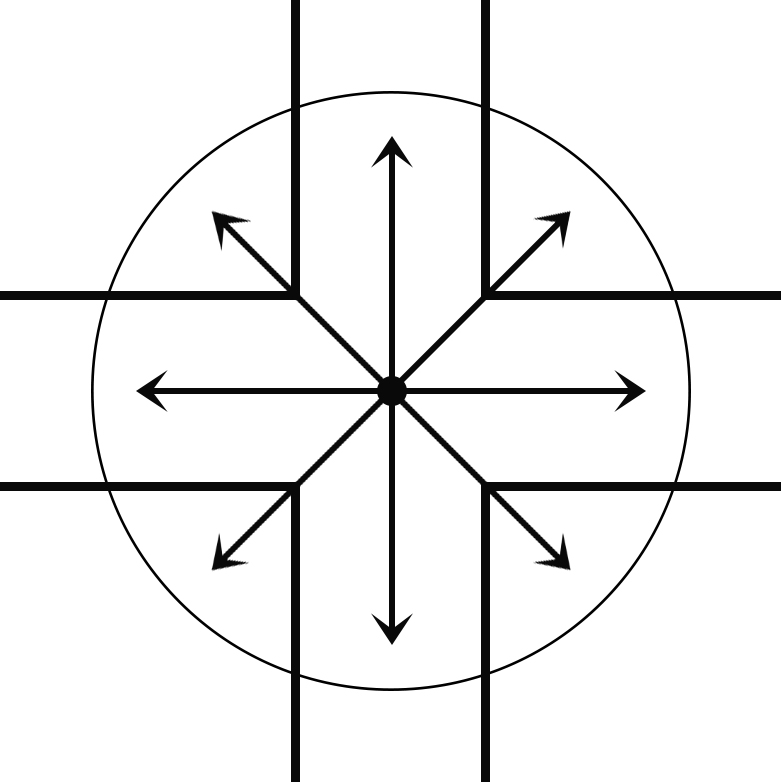
Type VS: A square symmetry of candlepower distribution.
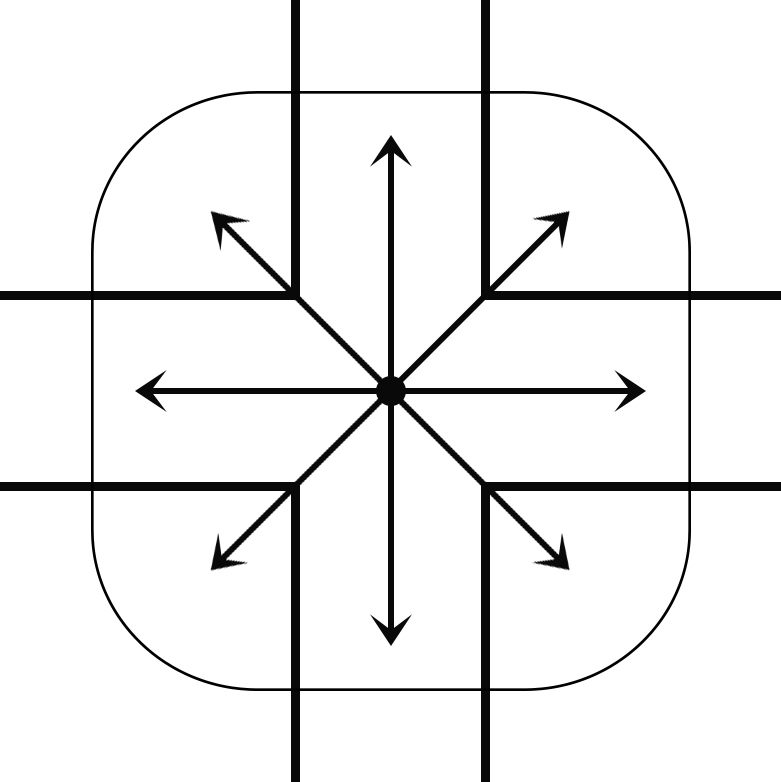
LCS and BUG Systems
Area luminaires are classified according to the IES Luminaire Classification System (LCS) which provides information regarding the lumen distribution within solid angles of specific interest. The LCS was developed to replace the old IES cutoff classifications (full cutoff, cutoff, semi-cutoff, and non-cutoff). The primary solid angles defined by the LCS are: Forward light, Back light, Uplight. Each of the primary angle is further divided into several secondary solid angles.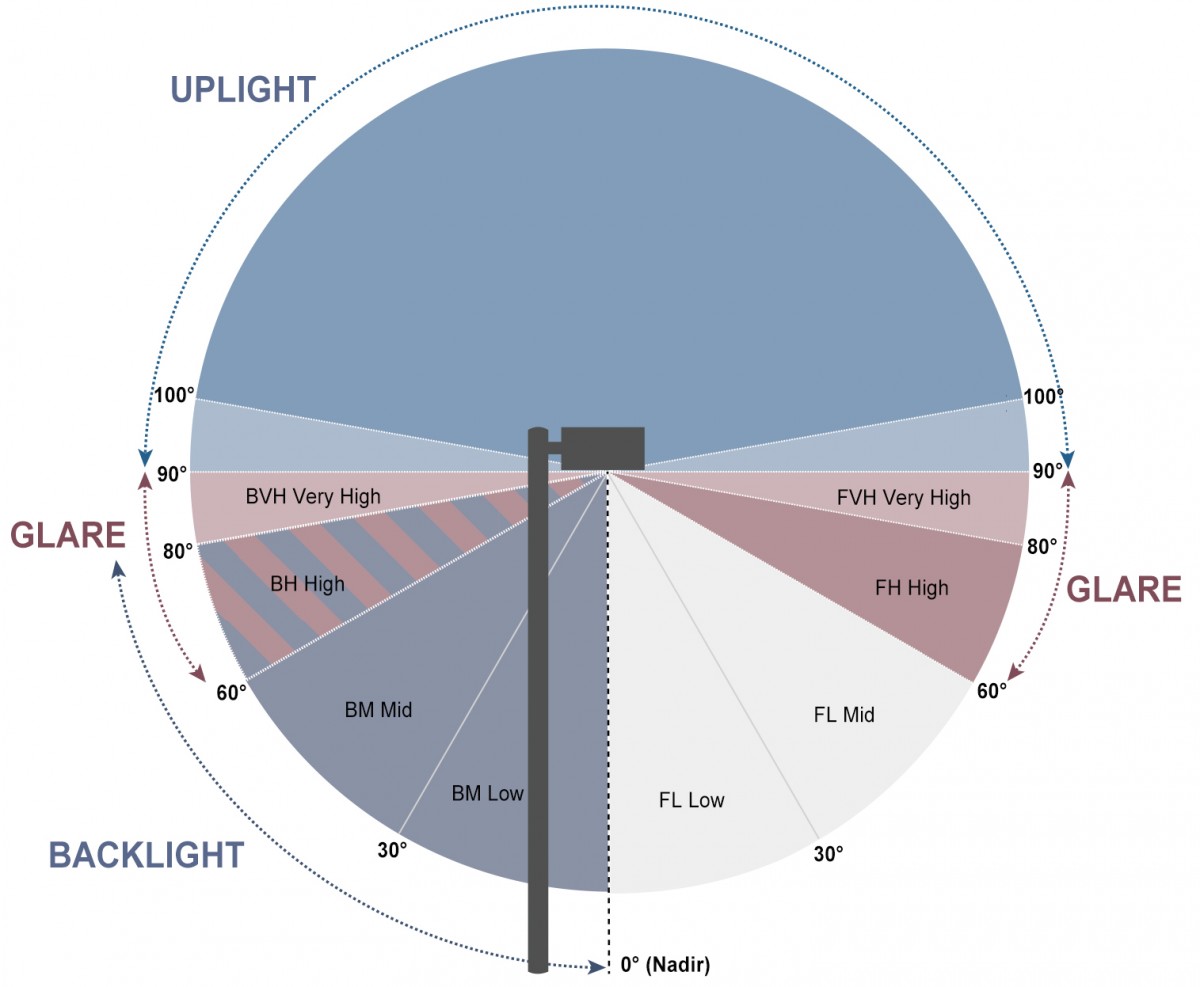
Forward light defines lumen distribution in front of the luminaire (0° - 90° vertical, 90° - 270° horizontal). This primary solid angle is further refined into 4 vertical secondary solid angles:
- Forward light low (FL, 0° - 30° vertical)
- Forward light mid (FM, 30° - 60° vertical)
- Forward light high (FH, 60° - 80° vertical)
- Forward light very high (FVH, 80° - 90° vertical)
Back light describes lumen distribution in back of the luminaire (0° - 90° vertical, 90° - 270° horizontal). This primary solid angle is also divided into 4 vertical secondary solid angles:
- Back light low (BL, 0° - 30° vertical)
- Back light mid (BM, 30° - 60° vertical)
- Back light high (BH, 60° - 80° vertical)
- Back light very high (BVH, 80° - 90° vertical)
Uplight describes lumen distribution between 90° and 180° vertical, and 0° - 360° horizontal. Its secondary solid angles include:
- Uplight low (UL): Lumens between 90° and 100° vertical, 360° around the luminaire
- Uplight high (UH): Lumens between 100° and 180° vertical, 360° around the luminaire
Based on the lumens in various Backlight, Uplight, and Glare subzones, a luminaire is given a Backlight, Uplight and Glare (BUG) rating which evaluates luminaire optical performance related to light trespass, sky glow, and high angle brightness control. This rating system provides B, U, and G values which range from 0 to 5, with 0 being the tightest control.
Enclosure Protection
High enclosure integrity is one of the key engineering requirements for outdoor luminaires which are exposed to harsh environmental rigors such as moisture ingress, thermal cycling, salt corrosion, UV degradation. Ingress protection is of particular importance for area luminaires as both the LEDs and electrical circuits of the luminaires can be damaged by the intrusion of moisture, water and contaminants. The absorption and diffusion of moisture in polymer plastic packages can lead to lumen degradation and cause encapsulant cracking due to hydro-mechanical stress and reduced interfacial adhesion strength. It is therefore necessary to exercise control of environmental conditions to avoid extrinsic failures. In general, the optical assembly of an area luminaire is required to maintain at least an IP66 rating.In outdoor environments, the pressure differentials inside and outside the luminaire enclosure caused by thermal cycling are a root cause of premature seal failure and IP degradation in air luminaires. A "breathing" membrane solution is thus used to equalize pressure and reduce condensation in the enclosure while locking out moisture and other contaminants.
The IP rating system
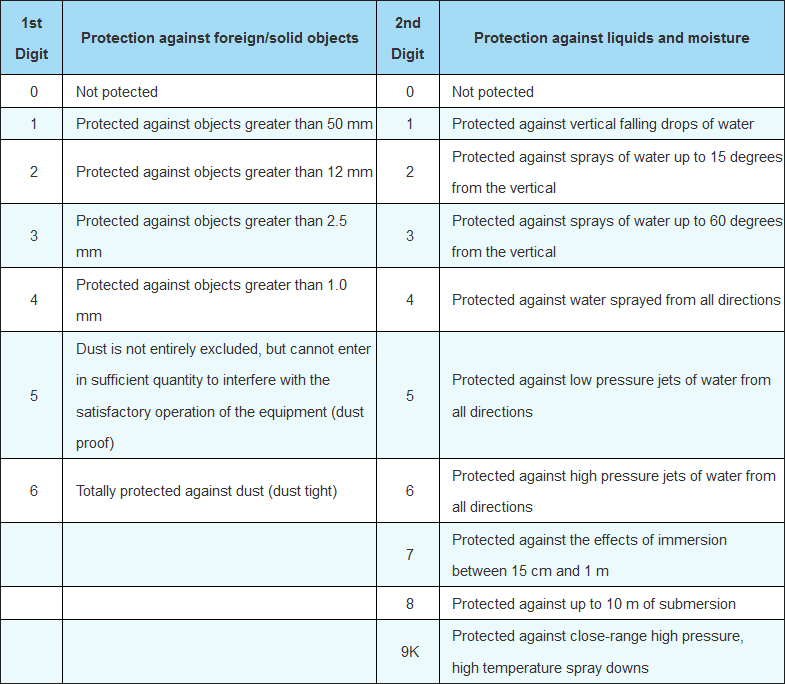
NEMA-to-IP Conversion
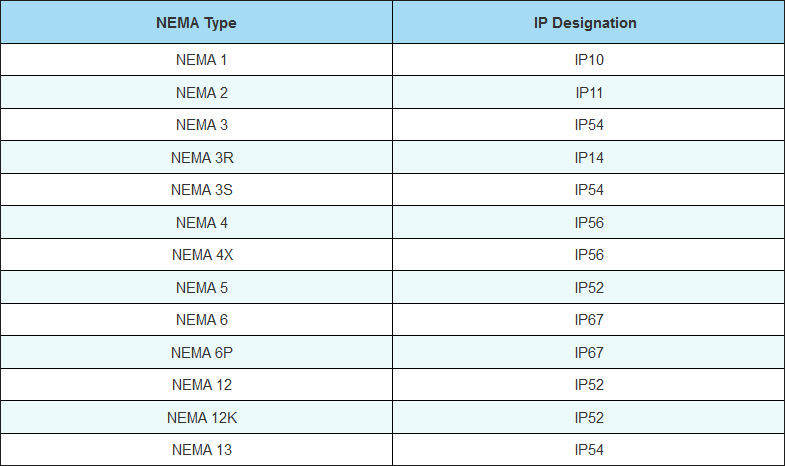
Surface treatment provides corrosion protection from environmental elements for luminaire enclosures. The aluminum housing undergoes a multi-stage cleaning and pretreatment process. A durable TGIC polyester powdercoat finish is then electrostatically applied to the housing. The protective finish allows the luminaire enclosure to resists extreme weather conditions, UV degradation and salt corrosion while providing optimal color and gloss retention.



































































